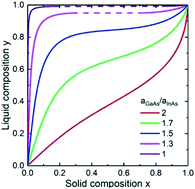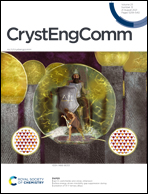Surface energy driven miscibility gap suppression during nucleation of III–V ternary alloys
Abstract
The existence of a miscibility gap limits the range of solid compositions which are possible to achieve under near-equilibrium growth conditions. Circumventing the miscibility gap is of paramount importance for device fabrication. We propose that one of the suppression mechanisms is the nucleus surface energy and explain how the surface energy influences the miscibility gap during nucleation from a liquid melt. By doing this, we start with the formation of the critical nucleus of a ternary alloy considering its surface energy as a combination of the binary ones. For certain nucleation scenarios in the InGaAs materials system we show that the compositional independence of the surface energy term is a good approximation due to similar values for InAs and GaAs pairs. However, a large difference in the surface energies of the two materials may lead to a significant modification of the liquid–solid composition dependence and a complete suppression of the miscibility gap.

- This article is part of the themed collection: Nanomaterials


 Please wait while we load your content...
Please wait while we load your content...